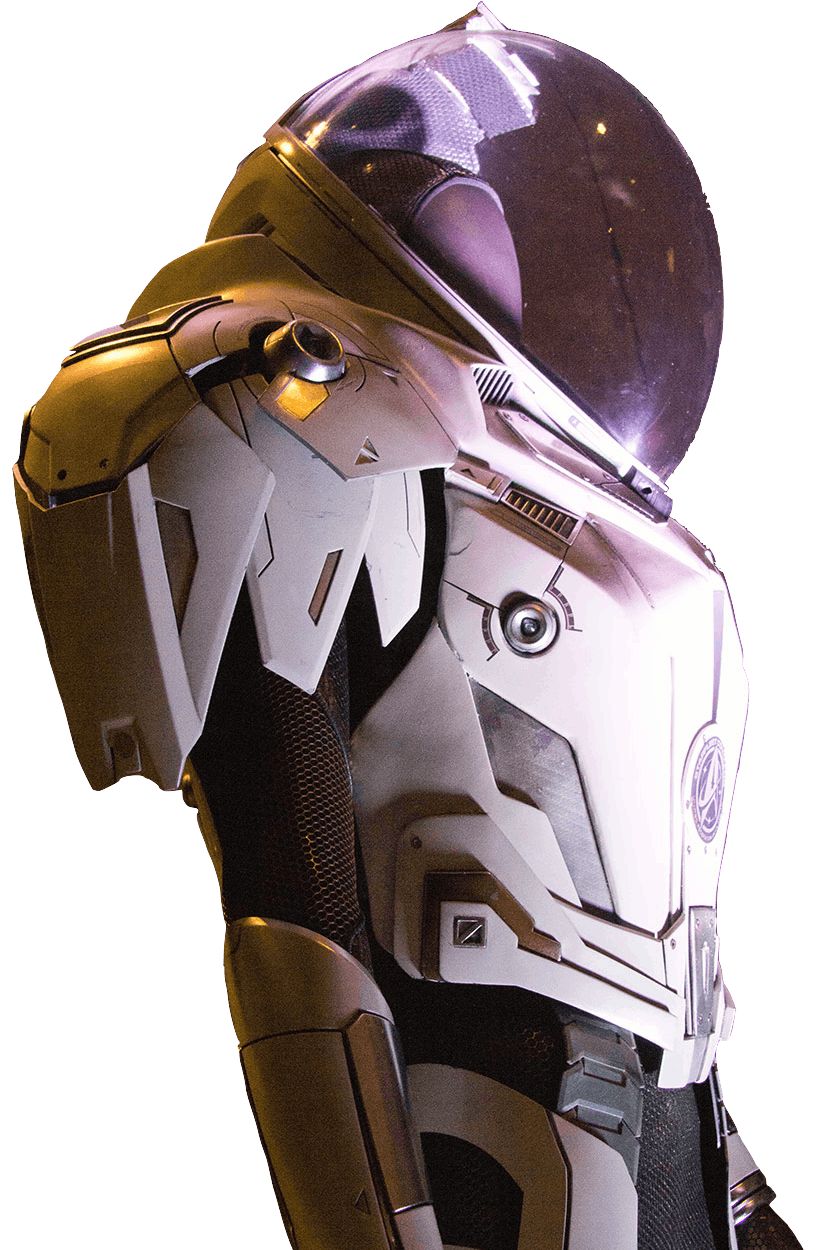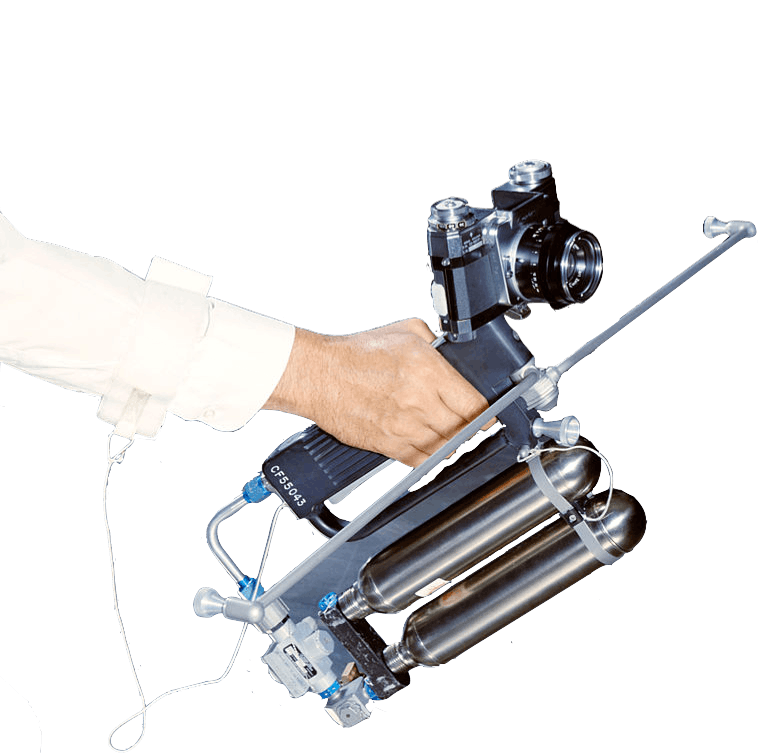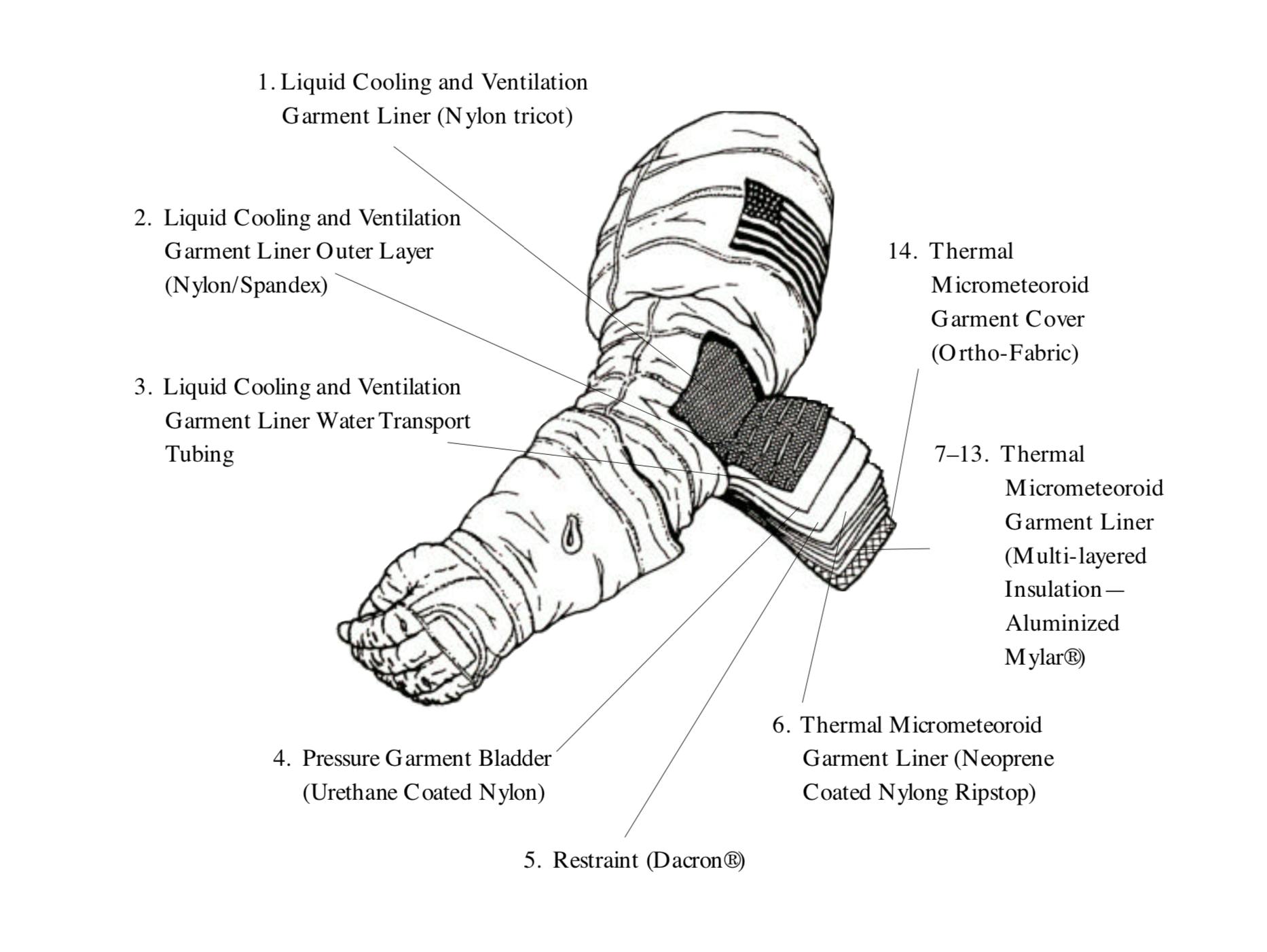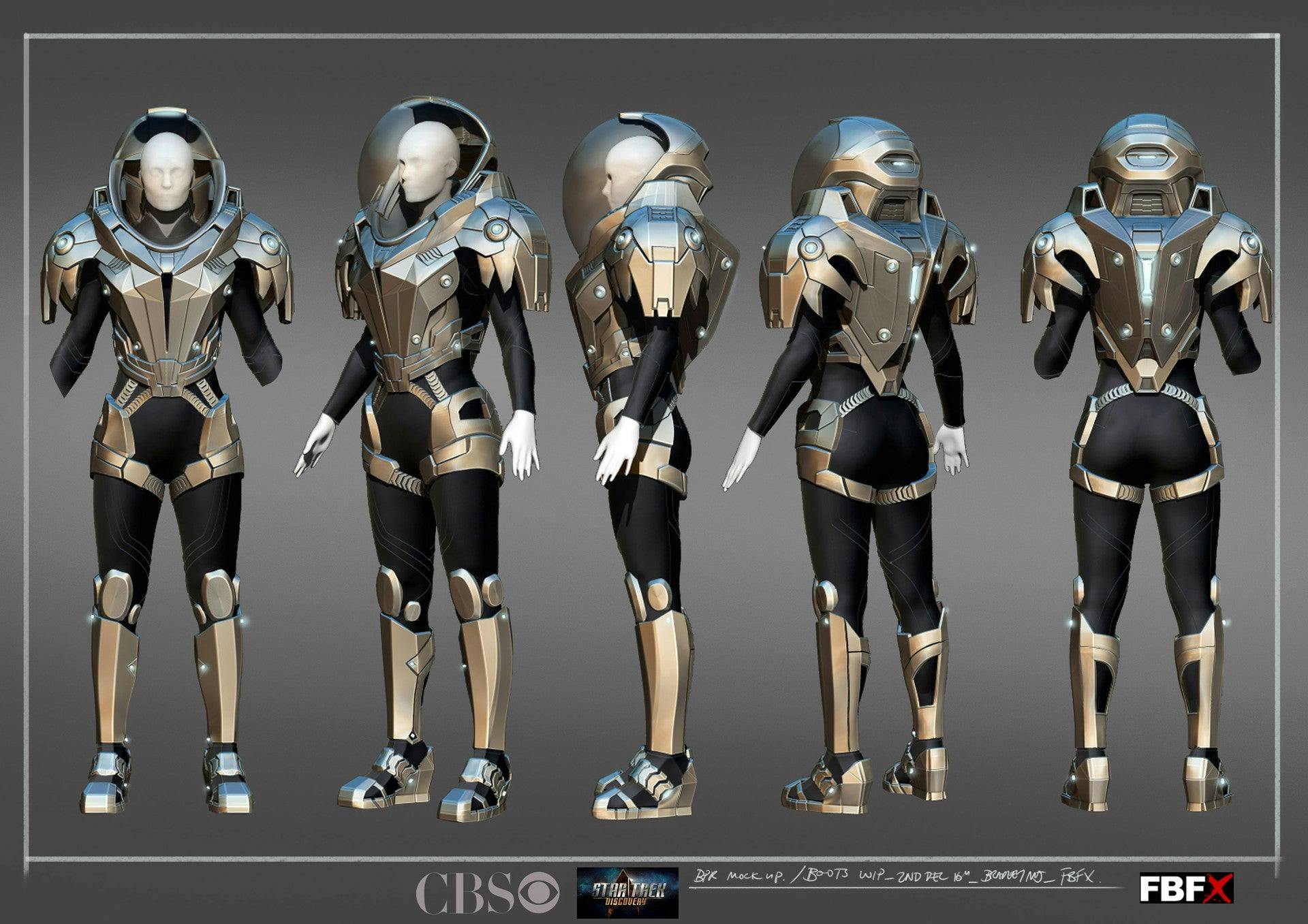Published Jan 2, 2021
'Discovery's Space Suits May be Closer to Reality Than You Think
Burnham's spacewalk look has a long history rooted in NASA's stellar work.

StarTrek.com
Remember Michael Burnham’s spacesuit from Star Trek: Discovery’s pilot episode? There’s a reason that futuristic, pearl-white thruster module with auto-navigation and heads-up helmet display looked so magnificent on screen. While the futuristic aesthetics of the suit put it right at home in the Trek universe, the foundation of its design is rooted in some real-world space suit tech. The Battle of the Binary Stars from “The Vulcan Hello” takes place in the year 2256, but given the current trajectory of human spaceflight technology and NASA’s recent commitment to land astronauts back on the Moon by 2024, Burnham’s thruster-pack-propelled away mission through the asteroids is on track to become a reality well before then.
Star Trek has a long history of predicting technologies. You’re probably reading this on a device that existed in Trek before it did in reality.

StarTrek.com
Spacesuits have an equally long history — about 3,500 words long, just so you know what you’re about to get yourself into. In fact, the origin of modern-day spacesuit design dates back to before the human race even had the means to consider rocketing free from Earth’s gravitational hold. The first space suit wasn’t that at all: It was a pressure suit. Being air-tight only fulfills one of many essential functions that go into protecting a human in the vacuum of space, but it is one of the most important steps.
Thankfully, this first suit wasn’t intended for space travel. As aviators of the early twentieth century were climbing to higher and higher altitudes, the need to combat the changes in air pressure became increasingly apparent. Modern-day spacesuit design can be traced back to the first man to fly solo around the globe. In 1934, American aviator Wiley Post wore the first functionally practical pressure suitable to sustain a pilot above 40,000 feet, which he commissioned the B.F. Goodrich Company to build.

NASA
The first successful space suit was built by the Soviet Union, and worn by Yuri Gagarin in 1961 on humanity’s first flight to space. In the early days of spaceflight, Mercury astronauts wore modified versions of the U.S. Navy’s flight suits for high-altitude aircraft. A hyper-evolved version of Wiley Post’s original suit (and designed by the same engineer), the chrome space suits from NASA’s Mercury program got their shine from an upgraded aluminum-coated nylon material for external thermal control, and a ventilation system designed to circulate oxygen throughout astronauts’ full-body garments.
There’s an important distinction to be made here: Mercury astronauts wore these suits to space, and they certainly are considered space suits, but they were not equipped to protect astronauts from the full exposure of elements beyond Earth’s atmosphere. These are known as Intravehicular activity (IVA) suits, meant to be worn inside pressurized cockpits or vessels. Stepping outside the spacecraft requires a lot more protection.
Let’s say you wanted to open the hatch of your spaceship, go out into the vacuum, zip over to a mysterious Klingon ship, and start an interstellar war. That would be known as Extravehicular Activity (EVA), and without the thick layers of a vehicle’s bulkhead between you and the unforgiving environment of space, you’re exposed to a lot.

StarTrek.com
Temperatures in space can vary between 250°F and -250°F. EVA suits need to protect from increased radiation and micrometer impacts, which can collide with an orbital velocity of up to 22,500 mph. They do all this while circulating breathable oxygen, removing carbon dioxide, maintaining adequate pressure control, communications systems, and providing enough flexibility for astronauts to perform complex tasks in microgravity with precise dexterity.
EVA suits are essentially tiny, one-person spaceships. They had a rocky early development, but a quick evolution as the 1960’s space race pitted the Soviets against the U.S. in a rush for orbital milestones. In March 1965, Soviet cosmonaut Alexei Leonov, the first human to perform a spacewalk, nearly didn’t make it back in his capsule due to the difficulties of maneuvering in zero-g. Just over two months later, Ed White performed the first EVA by an American astronaut but didn’t fare much better when it came to getting around. Still, he had a great time: “I feel like a million dollars!”

NASA
White brought along the Hand-Held Maneuvering Unit (HHMU) experiment -- A propellant-filled gun designed to aid astronauts’ movement during EVA -- when he left his spacecraft. Versions of the HHMU were used on the Gemini 4 and 10 missions, and it was the first evolutionary step towards more advanced, thrust-enabled EVA mobility technology. It’s the true ancestral origin for Discovery’s thruster-equipped spacesuit design.
The Gemini missions served as a proving ground for NASA’s plans for Apollo. Demonstrating an astronaut's ability to effectively operate outside a spacecraft during EVA was crucial to landing on the Moon. Five Gemini astronauts completed nine separate EVAs to help NASA build the best space suit. Different iterations of EVA suits found their way onto subsequent Gemini missions as NASA engineers tackled new issues every flight. Aside from difficulties working and moving in microgravity, astronauts experienced extreme over-heating, harsh rigidity and over pressurization in their suits, and some even developed burns due to exposure.

NASA
It wasn’t until Gemini 12 in 1966 that NASA astronauts would truly learn to work in space. Astronaut Edwin “Buzz” Aldrin, who would walk on the Moon three years later, helped pioneer the development of NASA’s early EVA suits by focusing on function and design for working without gravity. An expert deep-sea diver, Aldrin trained for his EVAs underwater to simulate weightlessness, adding handrails to the spacecraft’s exterior and adapting tools to accommodate the suit’s reduced dexterity. To this day, astronauts train for EVAs underwater in NASA’s Neutral Buoyancy Lab at the Johnson Space Center in Houston, Texas.
Design improvements and advancements leading up to the Apollo program brought about one of NASA’s most iconic spacesuit concepts, known as the Extravehicular Mobility Unit (EMU). Modern EMU engineering has evolved the design into a semi-rigid suit with two main pieces, but the term refers to every EVA suit worn during the Apollo and Skylab programs until today.
The upper part of the suit, the chest and an attached backpack, contains the electrical, communications, life-support, temperature regulation, and pressure control systems. The lower half, which attaches at the torso, covers the wearer from the waist down and completes the pressure suit.
EMU suits are all about layers. For Lunar excursions, suits had to be rugged, rip-proof, and lightweight while providing hours of life-support for astronauts to explore the Moon. The protection from elements not offered by an IVA suit can be found in the EMU’s interior linings, including a liquid transport tubing system for regulating temperature, a urethane-coated nylon pressure mantle, with neoprene-coated nylon, aluminized mylar, and nanowoven Dracon to shield against micrometeoroid impacts.

NASA
Unused suits from the Apollo program would undergo modification for use on Skylab, America’s first space station, which hosted a total of ten EVAs during three crewed missions. Following 1974 and Skylab’s decommission, NASA astronauts didn’t perform another EVA for over nine years. Enter the Space Shuttle.
Packed with upgrades, ILC Dover, the same company contracted by NASA to build EMUs for Apollo, designed and built new ones for the Space Shuttle program. Before the Space Shuttle, space suits were single-use, and custom-built for each astronaut. The new suits were not only reusable, but they also featured modular components to allow size adjustments for different crew members. The suits made their EVA premiere during Challenger’s first mission in 1983.

NASA
The next year, NASA launched the Manned Maneuvering Unit (MMU), built by Lockheed Martin — they also built the Lunar Landers. The MMU flew on three separate Space Shuttle missions in 1984, and was primarily used by astronauts for satellite retrieval and repair. If Ed White’s HHMU had Saru’s threat ganglia, Lockheed Martin chopped them off and evolved the technology into something with way more attitude.
The MMU was a self-contained, nitrogen gas-propelled, propulsion backpack with 24 multi-axis thrusters controlled with two joysticks for flying around untethered from the Space Shuttle. The closest real-world predecessor to Burnham’s thruster-pack, the MMU was canceled under NASA’s tightened safety belt following the Challenger disaster in 1986.
Of the 18 EVA suits provided to NASA from ILC Dover, only 11, at most, remain today. They are split between use on the International Space Station (ISS) and NASA’s testing facility at the Johnson Space Center. After the Space Shuttle program was canceled in 2011, the remaining EMUs got some major upgrades, which allowed them to be stored on orbit aboard the ISS long-term. However, reports in recent years cast serious doubt on NASA’s ability to produce viable replacements before the current suits enter their fifth operational decade.
A 2018 audit from NASA’s Office of Inspector General (OIG) projected a bleak timeline for new spacesuits that are crucially needed, stating, “the agency will not begin testing the advanced spacesuit on-orbit until the end of FY 2024 and will not complete testing until the end of FY 2025. As we reported in April 2017, NASA’s spacesuit development efforts have struggled from a lack of operational requirements, stable funding, and stable plans.”
So, how does this stagnation lead to some version of Disco’s space suit becoming a reality in our lifetime? In March 2019, NASA announced a new, extremely ambitious goal to take American astronauts back to the Moon by 2024. It’s called the Artemis Program, named for Apollo’s twin sister. NASA Administrator Jim Bridenstine recently revealed the name, along with more details about the space agency’s plan to “carry the next man and the first woman to the Moon.”
If NASA wants to stick to that goal, they have to seriously ramp up production. The space agency has been developing a heavy-lift rocket it calls the Space Launch System (SLS), and an accompanying crew capsule named Orion, for the better part of decade. Plans for the space agency’s next Moon-shot have the SLS's maiden launch, Exploration Mission-1 (EM-1), scheduled for June 2020.

NASA
Vice President Pence presented the Moon 2024 goal at the fifth meeting of the National Space Council (NSC) on March 26. Less than two weeks prior to that, Administrator Bridenstine told members at a Senate Commerce Committee hearing that SLS, and Orion’s EM-1 would likely be delayed until 2021. In the weeks that followed Pence’s speech, Bridenstine reconfirmed SLS could be ready to launch by its June 2020 target — with some help. A new budget increase for NASA is helping them stay on schedule, and the mission was given an updated name: EM-1 is now Artemis 1.
Additional funds included, NASA still has a long way to go. Meeting the Moon 2024 goal requires establishing a permanent lunar space station, coordinating contracts to design and build robotic and human lunar landers with descent and ascent vehicles, and — you guessed it — new spacesuits. Lots of them: IVA suits for launch, and different EMU suits for lunar space station EVAs and surface excursions. The ones currently in use just aren’t an option, the OIG report outlines:
“Although the spacesuit currently used on the ISS for extravehicular activities (spacewalks) is suitable for operations in low Earth orbit, it does not offer the mobility, durability, or functionality planetary or cislunar missions will require.”
What will astronauts wear on moonwalks in 5 years? We're currently working on options for our #Moon2024 mission + beyond. We'll have a transition suit for 1st mission + modern spacesuit designs for astronauts to explore the lunar surface & help create our sustainable lunar future pic.twitter.com/HhDyvIC1L1
— NASA (@NASA) May 1, 2019
It seems like a lot. But a lot has been going on in the interim to prepare the space agency for just these types of challenges.
Since NASA’s retirement of the Space Shuttle grounded America’s only ability to send astronauts to space from American soil, the space agency has been working with private aerospace companies like SpaceX and Boeing to contract new crew-capable vehicles. SpaceX’s Crew Dragon vessel completed an uncrewed test flight to the ISS in early 2019, and Boeing’s CST-100 Starliner is scheduled to do the same later this year.

StarTrek.com / SpaceX
Accompanying these shiny new spaceships, SpaceX and Boeing also developed new IVA suits for astronauts to wear while they’re along for the ride. SpaceX’s new suit, especially, sits right at home in an aesthetic progression to Star Trek’s sci-fi design. Its sleek profile and beautifully intricate textures and lines would be easy to mistake for the uniform of one of the U.S.S. Discovery’s medical officers.
SpaceX and Boeing aren’t the only companies shooting for the stars — or a lucrative NASA contract. Final Frontier Design (FFD) engineers and manufactures IVA and EVA suits, and has partnered with NASA on a number of scientific contracts. NASA’s urgency to establish a permanent presence on the Moon is really only a stepping-stone. The ultimate goal of the program is to send humans to Mars in the 2030s. A mission which will require yet another type of EVA suit — one capable of traversing the Martian surface.
Kellie Gerardi, who has spent the past eight years in the aerospace and defense industry, is one of the people getting to test those suits first-hand. Gerardi participated in a research expedition at the Mars Desert Research Station, a remote laboratory in Utah used to simulate scientific research on Mars.

Kellie Gerardi
Gerardi is a Scientist-Astronaut Candidate with Project PoSSUM, the first crewed suborbital research program, and has flown missions in microgravity with FFD’s IVA suit as well. Through email correspondence, she described her experiences with FFD’s suit, and her residency working at the remote outpost as one of her favorite expeditions. “I spent three weeks in isolation with scientists from NASA, JAXA, and private industry, and we tested one of FFD's prototype spacesuits, donning it every time we left the Hab for geological surveys and other EVAs.”
“I've been blown away by the advancement in spacesuit technology over the past few years,” Gerardi explained to StarTrek.com. A long way from the rigid suits of the Gemini missions, Gerardi describes these new suits as “very comfortable and flexible,” and the gloves, she says, are the best part:
"FFD was actually founded during their prize-winning entry to NASA’s 2009 Astronaut Glove Challenge, where their pressurized gloves outperformed NASA’s current technology in several key categories. Dexterity and tactility are so critical when you're operating payloads with delicate mechanisms (or even when you're simply trying to buckle back into your 5-point harness in zero-g!), and FFD's pressurized IVA gloves are state-of-the-art: custom-molded fingertips, enhanced range of motion, and capacitive touchscreen compatibility.”
This certainly paints a brighter picture for humanity’s future in space. But even FFD’s spacesuit design doesn’t quite bridge the gap to Disco's skin-tight, asteroid-dodging, auto-piloted EVA experience. There is, however, an experimental space suit already in existence that might get us one step closer.
A constant struggle for spacesuit engineers is the balance between girth and flexibility. Older space suits could balloon up and make it hard to maneuver. Gas-pressurized suits today don’t have that problem, but that hasn’t made them any less bulky or cumbersome. Burnham’s suit on Discovery is neither of those things.

NASA
Under the main torso and helmet section of Disco’s suit, Burnham is wearing a very sleek, copper-toned, full-bodied leotard. It doesn’t seem like it would offer a lot of protection. In fact, when Saru is arguing against Commander Burnham’s EVA in “The Vulcan Hello,” he points out she would only survive twenty minutes before lethal radiation exposure.
Granted, the U.S.S. Shenzhou was much closer to the binary stars than the distance from Earth to our single star much farther away, so twenty minutes in a sci-fi onesie with a jetpack seems like a justifiably reasonable exposure limit. It’s safe to assume Starfleet engineers made sure the suit would shield from radiation in normal conditions. But could a suit like that really protect you in a vacuum?
Using mechanical counterpressure, suits made from skin-tight garments that press directly against the body could, theoretically, protect a person in a vacuum. Rather than floating around in a gas-pressurized bubble, a mechanical counterpressure suit would offer its wearer the same protection with the flexibility of a pair of yoga pants.
This isn’t a new idea. It was first theorized in the 1950s, and NASA even built a prototype in the '60s, but abandoned the project for the more fully developed EMU at the time. The space agency made some headway in recent years though, when it funded a project at MIT. The project team produced a prototype material capable of retaining its shape when exposed to electrical impulse or certain temperatures, providing rigid pressure and simultaneous suit flexibility. The technology is far from viable today, but its development mimics the look and function of Burhnam’s suit on Discovery, and will most certainly be a reality before we’re putting warp drives in starships.
So, let’s take a look at some of the other technological inspirations that went into Disco’s suit. Artist and digital sculptor Bradley Morgan Johnson (that’s his signature on the concept art there) helped bring Star Trek: Discovery’s 2D suit concepts to life. Johnson worked at London-based FBFX special effects company where the suit was designed. In a conversation about his time there and his work on Disco’s suit, Johnson explained, “FBFX got the contract because they’re the guys that have done so many cool space suits you’ve seen in films.”

StarTrek.com
He’s not wrong. The number of movies FBFX has worked on is massive, but their work designing space suits is especially impressive. Just some of their portfolio includes: Event Horizon (1997), Lost in Space (Movie 1998), Prometheus (2012), The Martian (2015), Life (2017), Alien: Covenant (2017), and Lost in Space (Netflix 2018).
Movies like The Martian require hyper-realistic suits, and FBFX has worked with NASA in the past to make sure to get it right. When it came to Discovery’s suit, Johnson said, “it was all about the Star Trek brand.”
Discovery’s space suit fits perfectly within the Trek universe. Star Trek: Enterprise — 100 years before Discovery in the timeline — featured EVA suits that mimicked and miniaturized the over-the-head systems and helmet design from NASA’s present-day EMUs. Enterprise’s suits still had a few tubes and cables to contend with, and serve as the Trek universe’s link between the trajectory of real-life space suit development and Discovery. If Elon Musk’s SpaceX can land whole rockets on ships at sea, it’s not a stretch to assume an advanced version of the same type of guidance system could circumnavigate an asteroid field with an MMU-style astro-jetpack.
Standing side by side, it’s easy to see the evolutionary progression from NASA’s early suits to the Star Trek universe. The designers of Discovery’s suit expertly evolved existing technology, combined it with an aesthetic familiar to the Star Trek franchise, and extrapolated emerging real-world advancements to create one of the show’s most iconic new props. The end result was a space suit deserving of its place within Trek canon.

StarTrek.com / NASA
Josh Dinner (he/him) is a freelance space journalist, science communicator, and occasional rocket launch photographer living in Bloomington, IN. He is committed to spreading STEM advocacy and excitement about the cosmos around us. His earliest memory is watching Star Trek. Read more of his work at www.theOrbital.space.
Star Trek: Discovery streams on Paramount+ in the United States, airs on Bell Media’s CTV Sci-Fi Channel and streams on Crave in Canada, and on Netflix in 190 countries.
